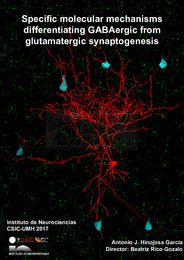Please use this identifier to cite or link to this item:
https://hdl.handle.net/11000/4756Full metadata record
| DC Field | Value | Language |
|---|---|---|
| dc.contributor.advisor | Rico Gozalo, Beatriz | - |
| dc.contributor.author | Hinojosa García, Antonio J. | - |
| dc.contributor.other | Instituto de Neurociencias | es |
| dc.date.accessioned | 2018-07-09T16:29:34Z | - |
| dc.date.available | 2018-07-09T16:29:34Z | - |
| dc.date.created | 2017-09-12 | - |
| dc.date.issued | 2018-07-09 | - |
| dc.identifier.uri | http://hdl.handle.net/11000/4756 | - |
| dc.description.abstract | Synapse formation is one of the most critical events in brain circuit wiring. Glutamatergic pyramidal cells and GABAergic interneurons in the cortex form their synaptic connections through a series of highly orchestrated events. Different genetic programs in both cells leads to basic differences in the process of synapse formation that includes targeted axonal pathfinding. While glutamatergic axons are rather straight and form their synapses through the subsequent extension of protrusions, GABAergic axons are more tortuous and form relatively more crossings with their synaptic targets. This body of data suggests that GABAergic axons look more actively for their synaptic targets while growing. However, little is known about the molecular mechanisms that generate these basic differences. In the present study, we carried out for the first time a high-throughput screening for genes differentially upregulated during synapse formation in both populations of cells. Subsequently, the role of the most striking genes in synaptogenesis was assessed by loss-of-function experiments. We found that Nek7, a kinase involved in microtubule polymerization, is specifically expressed in a high proportion of parvalbumin (PV) cells during synaptogenesis. Targeted elimination of Nek7 from PV interneurons causes a reduction in the number of synaptic boutons they form onto pyramidal cells, as well as a reduction in the size of their neuritic arbour in vivo. Furthermore, axons lacking Nek7 show a more meandering path when grown in vitro. Galectin-1 (Lgals1), another gene found in the screening, is expressed by somatostatin and PV interneurons. In contrast with Nek7, removing Lgals1 does not cause any synaptic deficit. Altogether, these data show that our screening is capable of identifying molecules differentially involved in GABAergic interneuron wiring. Moreover, Nek7 findings suggest that the kinase may be involved in a novel molecular mechanism by which PV interneuron axons guide their growth through the formation of synapses. | es |
| dc.format | application/pdf | es |
| dc.format.extent | 176 | es |
| dc.language.iso | eng | es |
| dc.rights | info:eu-repo/semantics/openAccess | es |
| dc.subject | Redes neuronales (Neurobiología) | es |
| dc.subject | Sinapsis | es |
| dc.subject.other | CDU::6 - Ciencias aplicadas::61 - Medicina::616 - Patología. Medicina clínica. Oncología::616.8 - Neurología. Neuropatología. Sistema nervioso | es |
| dc.title | Specific molecular mechanisms differentiating GABAergic from glutamatergic synaptogenesis | es |
| dc.type | info:eu-repo/semantics/doctoralThesis | es |

View/Open:
TD Hinojosa García, Antonio.pdf
23,98 MB
Adobe PDF
Share:
.png)
